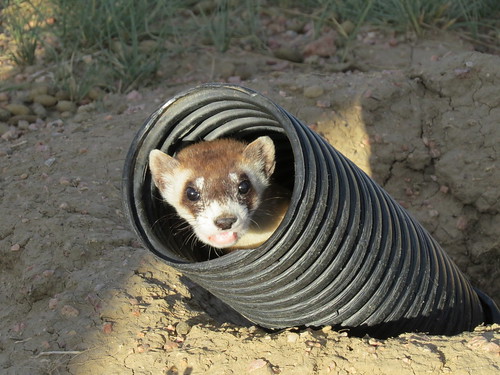
You can hear the chattering and scurrying from far away as six endangered black-footed ferrets restlessly wait in their travel carriers. These animals are the first of more than thirty scheduled for release this fall onto 34 square miles of prairie habitat at the Soapstone Prairie Natural Area and Meadow Springs Ranch in northern Colorado. The site is one of several new areas recently offered by local, State and Federal land management agencies and private landowners as reintroduction sites to aid in the recovery of the endangered black-footed ferret— America’s only native ferret.
Once thought to be extinct, black-footed ferrets are making a comeback thanks to a successful captive breeding program, multiple reintroduction sites across the West, and the hard work of many government agencies, non-governmental organizations, Tribes, private landowners, and concerned citizens.
The USDA-APHIS Wildlife Services (WS) program and USDA Natural Resources Conservation Service (NRCS) are both members of the Black-footed Ferret Recovery Implementation Team (BFFRIT), a multiagency group led by the U.S Fish and Wildlife Service (USFWS) and tasked with the long-term recovery of the ferret. Recently, Colorado WS State Director Mike Yeary, NRCS Acting State Conservationist Maria Collazo, several other dignitaries and members of the public gathered to release the six chattering black-footed ferrets onto Soapstone’s thriving prairie habitat.
“It’s an honor to be a part of this celebration and to welcome ferrets back to northern Colorado,” states Mike Yeary. “Wildlife Services looks forward to continuing its support of black-footed ferret recovery efforts here and in other states.”
WS works with the BFFRIT to provide prairie dog and disease management on participating lands. Prairie dogs are the primary food source for black-footed ferrets, but are susceptible to outbreaks of sylvatic plague. WS’ goal is to support prairie dog populations through disease prevention at ferret reintroduction sites while also limiting prairie dog expansion into other areas, if requested. Prairie dog management is designed not only to benefit the recovery of black-footed ferrets, but also to protect landowners and their neighbors from the expansion of prairie dog colonies into areas where they are not desired.
“Being a part of the recovery effort of one of the most endangered species— one which was once thought to be extinct— is not only exciting, it’s important,” shares NRCS’ Maria Collazo.
NRCS supports black-footed ferret recovery efforts as outlined within a Memorandum of Understanding (MOU) with the USFWS, APHIS-WS, Western Association of Fish and Wildlife Agencies, and the U.S. Geological Survey. The agency facilitates cooperative conservation efforts with willing landowners to maintain ranch land in prairie habitats and the livestock operations that they support, while also providing for the conservation and recovery of several wildlife species associated with prairie dogs.
After a short walk to the release site, and with many eyes watching, the six ferrets are quickly and quietly released onto the Soapstone prairie. A woman watching the release sums up everyone’s thoughts nicely. “Good luck, fella. Get out there, catch some prairie dogs and prosper.”
To see more photos from the release, please visit our FLICKR site. To learn more about USDA efforts related endangered species recovery, please visit the Wildlife Services and Natural Resources Conservation Service websites.

